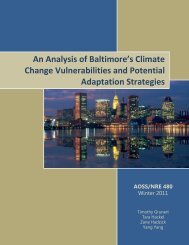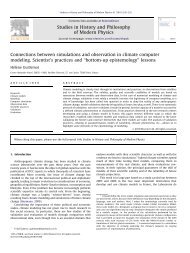Downloaded from rstb.royalsocietypublishing.org on April 14, 2010<strong>Carbon</strong> sequestration R. <strong>Lal</strong> 825Table 2. Comparative advantages and constraints of biotic versus abiotic options.parameters biotic (terrestrial) abiotic (engineering)the process natural (photosynthesis, humification) engineering (capture and injection)sink capacity finite (50–100 Pg) extremely large (thousands of Pg)time horizon immediate, for next 25–50 years 10–20 years from now, for long periodcost negative, none or low HighrisksNPP and biomass yield reduction minor or low N.A.human health minor to low (agricultural chemicals) Highenvironmental positive effect (win-win, no-regret) highleakage none or small (by ploughing, etc.) complex and expensive methodsmonitoring and verification simple and routine methods complex and expensive methodsregulatory measures monetary incentives may be helpful legislative and policy measures essentialadverse impacts of crop residueremoval on soil qualitysoil physicalqualitysoil chemicalqualitysoil biologicalqualitycrustingreduction innutrientreservesdecline inmicrobialbiomass Cdesertification and land degradationcompactionreduction ininfiltration rateincrease in run-off,evaporation anderosiondecrease inavailable watercapacitychange in soiltemperaturedecline inCECelementalimbalanceacidificationincrease inleaching lossesreduction inearthwormactivitydepletion of theSOC pooldecline in soilbiodiversitydisruption ofthe C cyclereduction in ecosystem servicesdecline in productivity and environment moderating capacityFigure 6. Adverse impacts of crop residue of cellulosic bioethanol production on soil and environment quality.in aesthetic and economic value of the soil. Therefore,the process of biotic C sequestration strengthens andenhances ecosystem services while enhancing agronomicproduction. The process is cost-effective, andRMPs for adoption on agricultural and forest soils/ecosystem are available for most ecoregions of theworld (IPCC 1999). However, the total sink capacityfor biotic C sequestration especially that in terrestrialecosystems is low at 50–100 Pg C over 25–50-yearperiod (<strong>Lal</strong> 2004a,b). Further, C sequestered in soiland biota can be re-emitted with change in soilmanagement (e.g. ploughing) and land use (e.g.deforestation) (table 2).In contrast to biotic sequestration, abiotic sequestrationis an engineering process. The technology fordeep injection in the ocean, geological strata, coalmines and oil wells, etc. are being developed and maybe routinely available by 2025 and beyond. At present,these techniques are expensive and injected CO 2 isprone to leakage. In addition to high cost, the issues ofmeasurement and monitoring, adverse ecologicalimpacts and regulatory measures need to be developedand implemented. However, the sink capacity of abiotictechniques is extremely large at thousands of Pg C, andoften estimated to exceed the fossil C reserves. Bioticand abiotic systems are complimentary to one another.Phil. Trans. R. Soc. B (<strong>2008</strong>)
Downloaded from rstb.royalsocietypublishing.org on April 14, 2010826 R. <strong>Lal</strong> <strong>Carbon</strong> sequestrationDepending upon ecosystem characteristics, there maybe site-specific ecological niches for biotic and abioticsequestration options. Biotic sequestration options areimmediately available. Use of such options buys ustime, while C-neutral energy production technologiesof alternatives to fossil fuels and techniques of abioticsequestration take effect.7. CONCLUSIONSAlthough natural terrestrial and oceanic sinks arepresently absorbing approximately 60% of the8.6 Pg C yr K1 emitted, natural sink capacity and rateare not large enough to assimilate all the projectedanthropogenic CO 2 emitted during the twenty-firstcentury or until the C-neutral energy sources takeeffect. The sink capacity of managed ecosystems (e.g.forest, soils and wetlands) can be enhanced throughconversion to a judicious land use and adoption ofRMPs of forestry, agricultural crops and pastures.Purposeful manipulation of biological processes canaccelerate the CO 2 sequestration process with adoptionof regulatory measures and identification of policyincentives. However, for these management systems tobe effective, there is a strong need for an integratedsystems approach. While the global C cycle is affectedby human activities, it is also coupled with cycles ofH 2 O and other elements (e.g. N, P, S) and effectivenessof biotic/terrestrial sequestration depends on scientificunderstanding of these coupled cycles.Abiotic sequestration of anthropogenically emittedCO 2 through direct injection in oceanic and geologicalstrata has a large sink capacity. Mineral carbonation ofCO 2 into stable carbonates of Ca and Mg is anotheroption with a large capacity. These engineeringtechniques are being developed and may be availablefor routine use by 2025 and beyond. Additionalresearch is needed to make these technologies costeffective,reduce leakage risks, minimize any adverseimpacts on the environment and enhance safety. Inaddition to economics, the human dimension issuesneed to be objectively and critically addressed for bothbiotic and abiotic CO 2 sequestration options. Appropriatepolicy and regulatory measures need to bedeveloped, especially with regards to measurement,monitoring, residence time and trading of carboncredits. While carbon sequestration is an importantstrategy, the significance of reducing emissions throughdevelopment of carbon neutral technologies cannot beoveremphasized. The latter may involve efficient energyproduction and usage measures, and finding alternativesto fossil fuel. Biofuels (e.g. bioethanol, bio-diesel,methane gas from biodigester and H 2 cell frombiomass) are an important component of alternativesources of energy.REFERENCESAnderson, S. H., Gantzer, C. J. & Brown, J. R. 1990 Soilphysical properties after 100 years of continuous cultivation.J. Soil Water Conserv. 45, 117–121.Arends, T. & Casth, P. 1994 The comparative effect ofequivalent amounts of NPK applied in farmyard manureor in fertilizers, as a function of soil properties. Agrok masTalajtan 43, 398–407.Armentano, T. V. & Menges, E. S. 1986 Patterns of change inthe carbon balance of organic wetlands of the temperatezone. J. Ecology 74, 755–774. (doi:10.2307/2260396)Arrhenius, S. 1896 On the influence of carbonic acid in theair upon the temperature of the ground. Phil. Mag. J. Sci.(London, Edinburgh, Dublin) 41, 237.Auerbach, D. I., Caulfield, J. A., Adams, E. E. & Herzog,H. J. 1997 Impacts of ocean CO 2 disposal on marine life: atoxicological assessment integrating constant-concentrationlaboratory assay data with variable concentrationfield exposure. Environ. Model. Assess. 2, 333–343.(doi:10.1023/A:1019029931755)Baines, S. J. & Worden, R. H. (eds) 2004 Geological storage ofcarbon dioxide. London, UK: The Geological Society.Batjes, N. H. 1996 Total C and N in soils of the world. Eur.J. Soil Sci. 47, 151–163. (doi:10.1111/j.1365-2389.1996.tb01386.x)Battle, M., Bender, M. L., Tans, P. P., White, J. W. C., Ellis,J. T., Conway, T. & Francey, R. 2000 Global carbon sinksand their variability inferred from O 2 and d 13 C. Science287, 2467–2470. (doi:10.1126/science.287.5462.2467)Bowman, R. A. & Halvorson, A. D. 1998 Soil chemicalchanges after nine years of differential N fertilization inno-till dryland wheat–corn–fallow rotation. Soil Sci. 163,241–247. (doi:10.1097/00010694-199803000-00009)Boyd, P. W. et al. 2004 The decline and fate of an ironinducedsub-arctic phytoplankton bloom. Nature 428,549–553. (doi:10.1038/nature02437)Brahic, C. 2006 Price crash rattles Europe’s CO 2 reductionscheme. Science 312, 1123. (doi:10.1126/science.312.5777.1123)Breslau, K. It can pay to be green: cleaner air means profits atthe climate exchange. Newsweek, 22 May 2006, p. 45.Bunker, D. E., DeClerck, F., Bradford, J. C., Colwell, R. K.,Perfecto, I., Phillips, O. L., Sankaran, M. & Naeem, S.2005 Species loss and aboveground carbon storage in atropical forest. Science 310, 1029–1031. (doi:10.1126/science.1117682)Buyanoski, H. A., Brown, J. R. & Wagner, G. H. 1997Sanborn field; effects of 100 years of cropping on soilparameters influencing crop productivity. In Soil organicmatter in temperate ecosystems in North America (eds E. A.Paul, E. Paustian, T. Elliot & C. V. Cole), pp. 205–225.Boca Raton, FL: CRC Press.Buyanoski, H. A. & Wagner, G. H. 1998 <strong>Carbon</strong> cycling incultivated land and its global significance. Global ChangeBiol. 4,131–141.(doi:10.1046/j.1365-2486.1998.00130.x)Campbell, C. A., Biederbeck, V. O., Zentner, R. P. & Lafond,G. P. 1991 Effect of crop rotations and cultural practiceson soil organic mater, microbial biomass and respiration ina thin, black Chernozem. Can. J. Soil Sci. 71, 363–376.Caulfield, J. A., Adams, E. E., Auerbach, D. I. & Herzog,H. J. 1997 Impacts of ocean CO 2 disposal on marine life:probalistic plume exposure model with a time-varyingdose-responsive analysis. Environ. Model. Assess. 2,345–353. (doi:10.1023/A:1019081915826)Chisholm, S. W., Falkowski, P. G. & Cullen, J. J. 2001 Discreditingocean fertilization. Science 294, 309–310.(doi:10.1126/science.1065349)Christensen, B. T. 1996 The Askov long-term experimentson animal manure and mineral fertilizers. In Evaluation ofsoil organic matter: models using existing datasets (eds D. S.Powlson, P. Smith & J. U. Smith). NATO, ASI 138,pp. 301–312. Heidelberg, Germany: Springer.Cramer, W. A. et al. 2001 Global response of terrestrialecosystem structure and function to CO 2 and climatechange: results from six dynamic global vegetation models.Global Change Biol. 7, 357–373. (doi:10.1046/j.1365-2486.2001.00383.x)Phil. Trans. R. Soc. B (<strong>2008</strong>)




